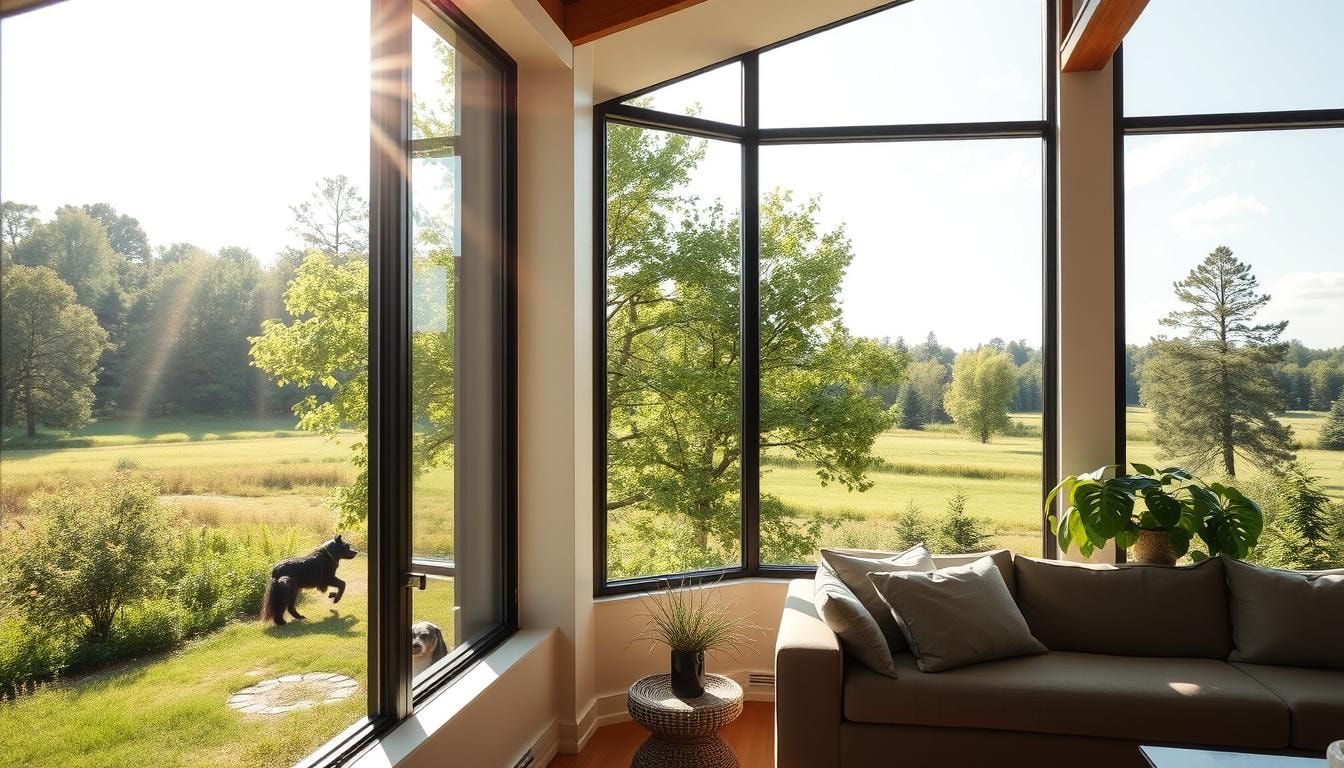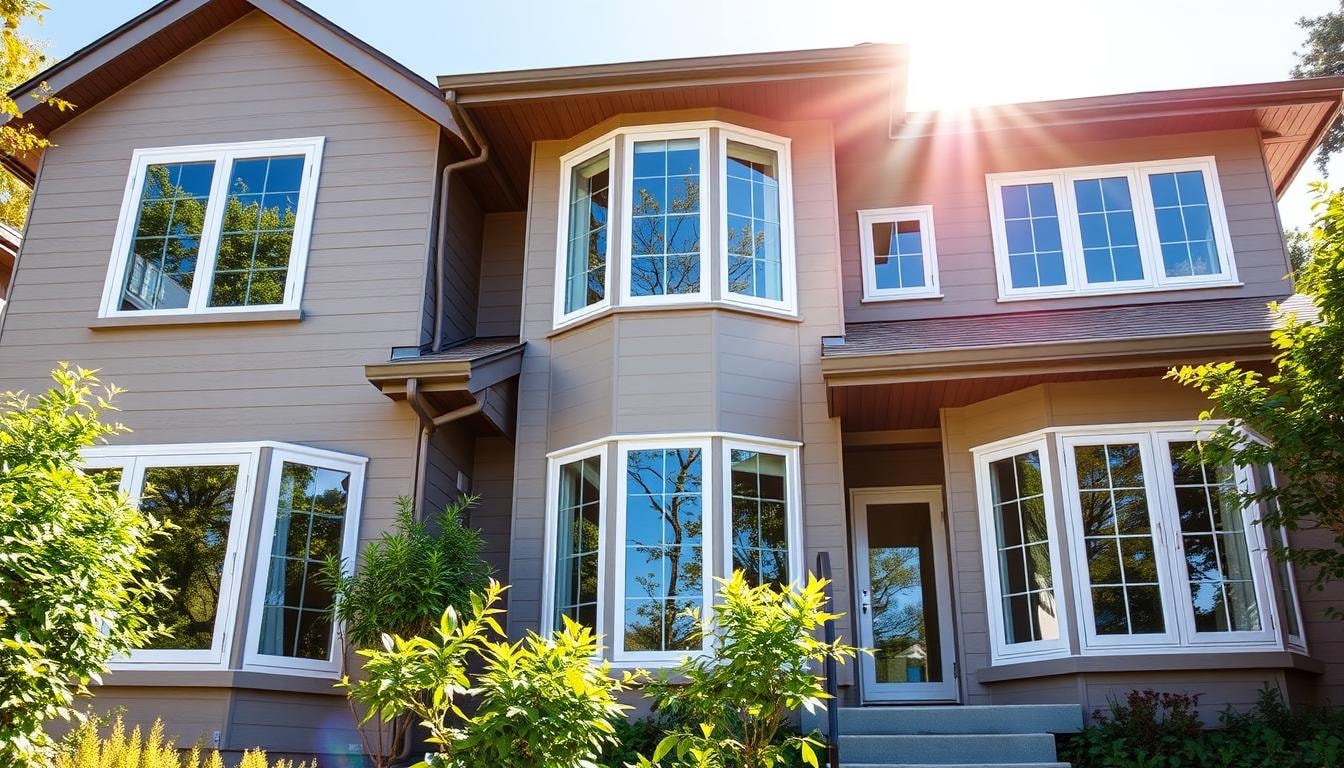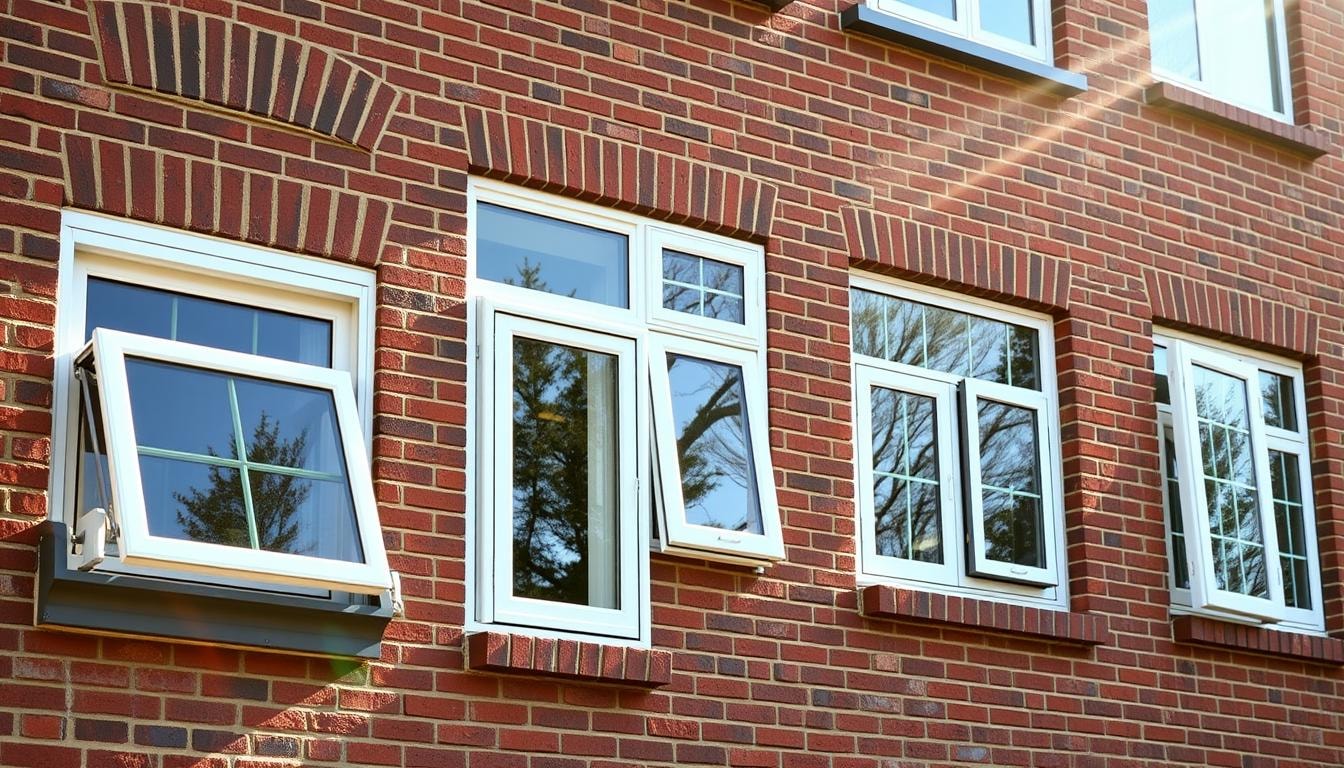
How to Measure for Replacement Windows in Brick: A Complete Guide
Replacing windows in a brick home needs careful planning and detail. This ensures the new windows fit well and save energy. The process of fitting new windows into existing brick openings is called brick-to-brick installation. It requires exact measurements for a perfect fit and a successful project.
This guide will show you how to measure windows correctly for brick-to-brick installation. It helps you avoid expensive mistakes and get a great window replacement job.
Key Takeaways
- Precise window measurements are crucial for a successful brick-to-brick window installation.
- Subtracting a quarter-inch from the shortest measurement is essential for exterior measurements on brick homes to allow for a proper fit.
- Professional window installers can complete a window replacement project significantly faster than DIY attempts, helping to avoid potential issues.
- Consulting with professional window installers can provide valuable advice and access to warranties.
Understanding Brick-to-Brick Window Installation Basics
Replacing windows in a brick home is easier with the brick-to-brick method. This way, the new window fits right into the old brick opening. You don’t have to remove any trim or siding. This keeps your home looking good and the brick wall strong.
- What is Brick-to-Brick Installation: The brick-to-brick method means the new window fits snugly with the brick. It’s supported by the brick, making it durable and energy-saving.
- Benefits of Proper Window Measurements: Getting the measurements right is key for brick-to-brick installation. Accurate measurements mean a perfect fit, saving time and money. They also keep the brick wall safe from damage.
- Common Installation Challenges: Brick-to-brick installation has its own set of challenges. Uneven brick or settling can make it tricky. Some window styles might not work, so you need experts. Always talk to a trusted window contractor for this job.
Essential Tools and Materials Needed for Measurement
Getting the right window measurements is key for a good replacement job. You’ll need a few important tools and materials to get it right. These include a 25-foot measuring tape, a pencil or marker, a notepad or smartphone, a leveler, and safety glasses.
The measuring tape is vital for finding the window’s width and height. Use a pencil or marker to mark important spots. A notepad or smartphone is handy for writing down your measurements. The leveler makes sure your measurements are straight and even. And don’t forget safety glasses to protect your eyes from any debris.
These tools and materials help you make a detailed record of your window’s size. With the right gear, you can measure accurately and avoid expensive errors. Getting ready is the first step to a successful window replacement.
- 25-foot measuring tape
- Pencil or marker
- Notepad or smartphone
- Leveler
- Safety glasses
Having these essential tools and materials means your window measurements will be accurate and reliable. This sets the stage for a smooth and successful replacement process.
Preparing Your Window Opening for Measurement
Before you can measure your window area, you need to get ready. First, remove any curtains, blinds, or other obstructions from the window. This will help you see the window clearly and measure it accurately.
Then, make sure you’re safe. Use strong ladders and wear protective gear like gloves and safety glasses. This keeps you safe while you work.
Initial Inspection Points
After clearing the area and getting safe, do a quick check. Look for any visible issues or irregularities in the window, like cracks or uneven spots. Finding these problems early helps you fix them during the measurement.
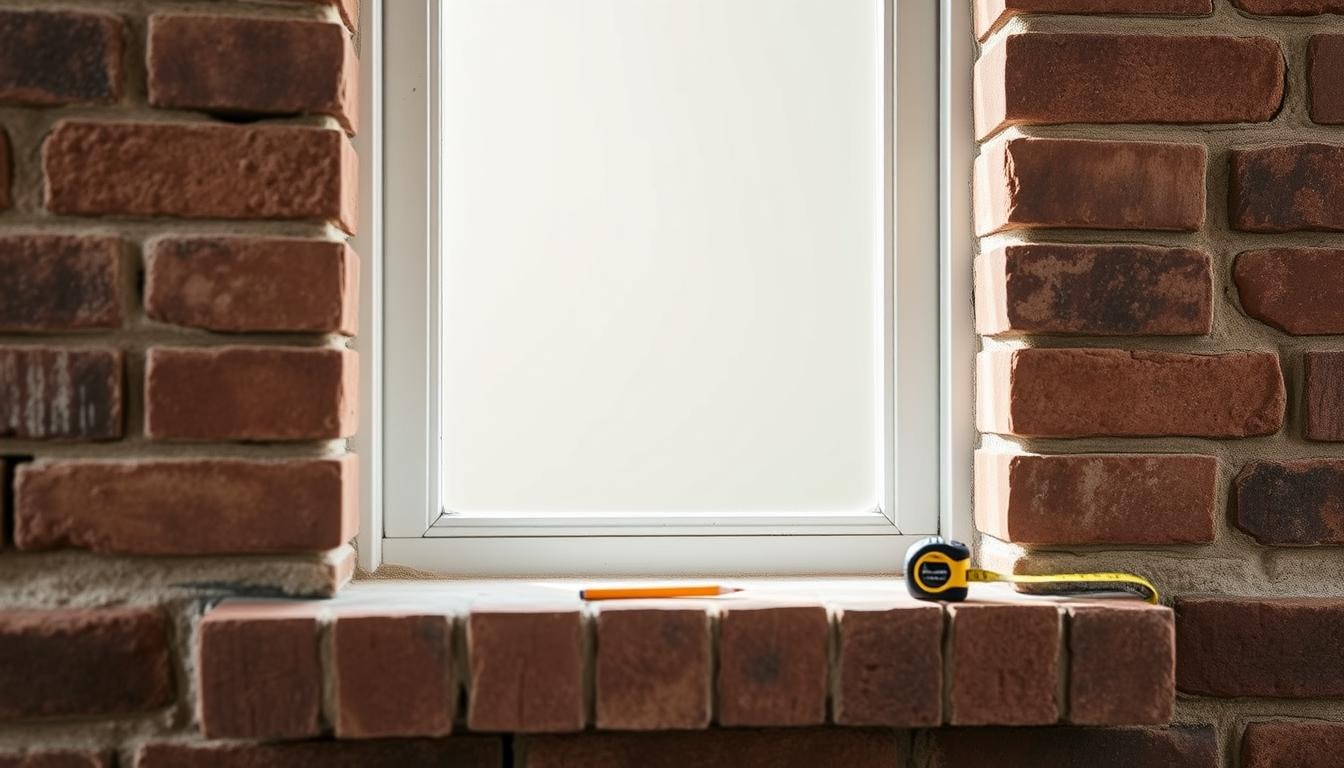
By doing these steps first, you’re ready for a precise window measurement. This makes your window replacement project go smoothly.
Taking Accurate Width Measurements
Measuring your window’s width is key to getting the right fit for new windows. You’ll need a good tape measure and a specific method to measure.
- Measuring at Three Points: Measure the window’s width at three spots: top, middle, and bottom. Make sure to measure from jamb to jamb, not including trim or exterior casing. This helps you understand the width at different points for a perfect fit.
- Recording the Smallest Measurement: After getting the three measurements, write them down. Then, find the smallest one. Use this smallest measurement to ensure your new window fits the narrowest part. This detail prevents gaps or issues during installation.
- Accounting for Clearances: When you calculate the final width, subtract about 1/2 inch from the smallest measurement. This clearance allows for proper installation and adjustments. Planning for these clearances saves time and trouble later.
By following these steps, you’ll find the perfect replacement window for your brick-framed opening. Use a tape measure and focus on the smallest measurement from jamb to jamb for a smooth window width fit.
Measuring Window Height Correctly
Replacing windows in a brick home needs accurate measurements for a good fit. Measuring the window height is a key step.
To get the window height right, start by measuring from the sill to the top of the frame. This is called the head jamb. Take measurements at three points: left, middle, and right. Use the smallest measurement to make sure the new window fits well.
- Measure from the sill to the head jamb on the left side of the window opening.
- Measure from the sill to the head jamb in the middle of the window opening.
- Measure from the sill to the head jamb on the right side of the window opening.
This way of measuring covers any unevenness in the opening. Using the smallest measurement ensures the new window fits perfectly in the brick frame.
Getting the window height right is key for a successful installation. By following these steps, you can avoid problems and get a snug fit for your new windows.
Understanding Window Depth Requirements
Replacing windows in a brick home needs the right window depth. The jamb depth is key for a good fit. It ensures your new windows fit perfectly.
Measuring Jamb Depth
To measure the jamb depth, start from the inside of the window frame to the outside. Measure at different points because frames can be different sizes. Standard depths are usually between 3 1/4 to 5 1/4 inches.
Determining Proper Extension Needs
Measure around trim or stops if you find them. Getting the right window depth is crucial for a tight fit. These measurements also show if you need extension jambs.
Measuring the jamb depth and checking for extension jambs is important. It makes installing your windows smooth. This care also makes your new windows last longer and save energy.
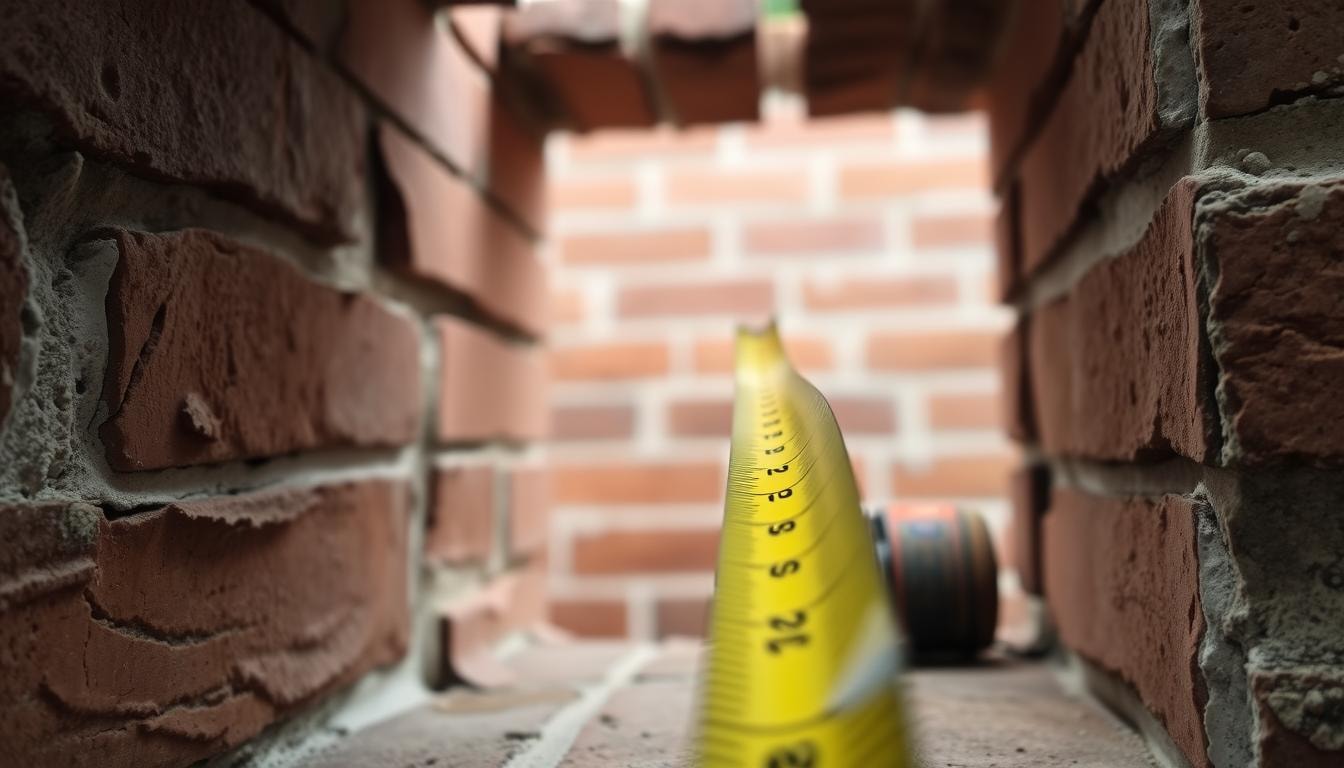
Common Measurement Mistakes to Avoid
Getting your window measurements right is key for a good fit and saving energy. Even skilled homeowners can make mistakes that cause problems. It’s vital to steer clear of these errors for a successful window upgrade.
One big mistake is measuring from the trim instead of the window frame itself. This can make the window too small, leading to gaps and bad insulation. Always measure the frame, including any odd shapes or angles in the opening.
- Not measuring at different points along the width and height can also cause issues. Since windows may not be perfectly square, measuring at the top, middle, and bottom helps account for any differences.
- Ignoring the smallest measurements is another common error. The new window must fit within the smallest dimension to ensure a tight, energy-efficient seal.
- Not considering unique features or obstacles, like window cranks or sills, can affect the window’s depth needs and cause installation problems.
Being careful with your measurements and double-checking your work can help you avoid expensive measurement errors. These errors can ruin window fit, energy efficiency, and installation. Taking the time to measure correctly is the first step to a successful window replacement project.
Professional Tips for Accurate Window Measurements
Measuring windows for replacement needs to be exact. Right measurements mean a perfect fit and avoid costly mistakes. Here are some tips from pros:
Recording and Double-Checking Measurements
Write down all measurements carefully and check them twice. Small mistakes can cause big problems. Keep a detailed record of your measurements, including the date and any notes.
Using Digital Tools and Apps
Use digital tools and apps for window measurements. They help with tricky shapes and save data for later. These tools make your measurements more precise.
Getting window measurements right is key for a good replacement. Follow these tips for a smooth installation. You’ll get energy-saving, custom-fit windows.
Upgrade Your Home with Budget Windows
Ready to replace those old windows and doors in your brick home? Let the experts at Budget Windows guide you through the process. Our team will provide a step-by-step guide to accurately measure your existing openings, ensuring the new construction windows and doors fit perfectly. Whether you’re looking for energy-efficient double-hung or single-hung styles, we have the right size and fit to maintain your home’s structural integrity and curb appeal.
From measuring the width x height to determining the necessary jamb extension, our professionals have the necessary tools and expertise to order the windows and doors tailored to your specifications. Don’t settle for less – contact Budget Windows today and let our experts transform the interior and exterior of your home with the perfect replacement windows and doors.
Conclusion
Getting accurate measurements is key for a good window replacement project in brick homes. This guide helps you get the right measurements. This ensures your windows fit well, save energy, and make your home more comfortable.
Always double-check your measurements. If you’re not sure, get help from a pro. With the right measurements, you’re ready to get and install your new, energy-saving windows.
Replacing windows in a brick home can be tricky. You might face uneven brick or moisture problems. But, with the right tools and methods, you can get past these issues.
FAQs
How can I ensure the new replacement windows fit properly in my brick house?
To ensure the new replacement windows fit properly in your brick house, taking precise measurements of the existing window opening is crucial. Measure the width at the top, middle, and bottom, and use the smallest measurement. Also, measure the height from the sill to the head jamb at three points and use the smallest height. Subtracting a quarter-inch from the shortest measurement will allow for a proper fit.
What tools and materials are needed to accurately measure for replacement windows in a brick house?
The essential tools and materials needed to accurately measure for replacement windows in a brick house include a 25-foot measuring tape, a pencil or marker, a notepad or smartphone, a leveler, and safety glasses. These will help you make a detailed record of the window’s size and ensure the measurements are straight and even.
How do I properly measure the depth requirements for replacement windows in a brick house?
To properly measure the depth requirements for replacement windows in a brick house, start by measuring the jamb depth from the inside of the window frame to the outside. Measure at different points, as frames can be different sizes. Standard depths are usually between 3 1/4 to 5 1/4 inches. Measure around any trim or stops to determine if you need extension jambs.
What are some common mistakes to avoid when measuring for replacement windows in a brick house?
Some common mistakes to avoid when measuring for replacement windows in a brick house include measuring from the trim instead of the window frame, not measuring at different points along the width and height, ignoring the smallest measurements, and not considering unique features or obstacles like window cranks or sills. Avoiding these errors will ensure a tight, energy-efficient seal for the new windows.
How can consulting with a professional help with the window replacement process in a brick house?
Consulting with a professional window installer can provide valuable advice and access to warranties for the window replacement process in a brick house. Professionals can complete the project significantly faster than a DIY attempt, helping to avoid potential issues. They can also provide guidance on the best window type and size for your brick house, ensuring the new windows fit properly and maintain the structural integrity of the home.





